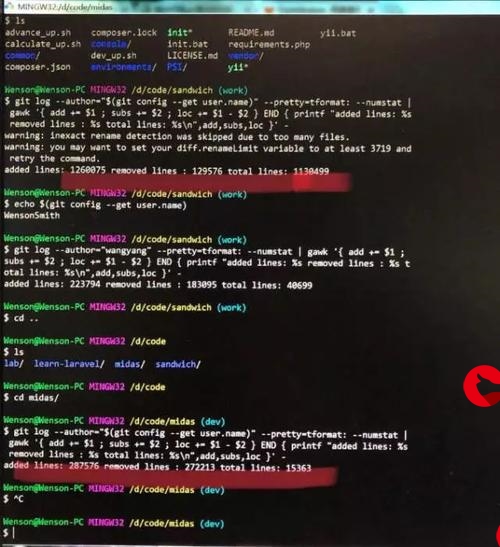 实用技巧总结"/>
实用技巧总结"/>
python实用技巧总结
1.处理用户的多个输入
有时我们需要从用户那里获得多个输入,以便使用循环或任何迭代,一般的写法如下:
# bad practice码
n1 = input("enter a number : ")
n2 = input("enter a number : ")
n2 = input("enter a number : ")
print(n1, n2, n3)
更好的处理方法
# good practice
n1, n2, n3 = input("enter a number : ").split()
print(n1, n2, n3)
2.处理多个条件语句
如果我们在代码中需要检查多个条件语句,此时我们可以使用 all() 或any() 函数来实现我们的目标。一般来说, 当我们有多个 and 条件时使用 all(),当我们有多个 or 条件时使用 any()。这种用法将使我们的代码更加清晰易读,可以方便我们在调试时不会遇到麻烦。
对于all()的一般例子如下:
size = "lg"
color = "blue"
price = 50
# bad practice
if size == "lg" and color == "blue" and price < 100:print("Yes, I want to but the product.")
更好的处理方法如下:
# good practice
conditions = [size == "lg",color == "blue",price < 100,
]
if all(conditions):print("Yes, I want to but the product.")
对于any()的一般例子如下:
# bad practice
size = "lg"
color = "blue"
price = 50
if size == "lg" or color == "blue" or price < 100:print("Yes, I want to but the product.")
更好的处理方法如下:
# good practice
conditions = [size == "lg",color == "blue",price < 100,
]
if any(conditions):print("Yes, I want to but the product.")
3 判断数字奇偶性
这很容易实现,我们从用户那里得到输入,将其转换为整数,检查 对数字2的求余操作,如果余数为零,则它是偶数。
print('odd' if int(input('Enter a number: '))%2 else 'even')
4 交换变量
在Python中如果需要交换变量的值,我们无需定义临时变量来操作。我们一般使用如下代码来实现变量交换:
v1 = 100
v2 = 200
# bad practice
temp = v1
v1 = v2
v2 = temp
但是更好的处理方法如下:
v1 = 100
v2 = 200
# good practice
v1, v2 = v2, v1
5 判断字符串是否为回文串
将字符串进行反转最简单的实现方式为 [::-1] ,代码如下:
print("John Deo"[::-1])
6 反转字符串
在Python中判断一个字符串是否为回文串,只需要使用语句
string.find(string[::-1])== 0 ,示例代码如下:
v1 = "madam" # is a palindrome string
v2 = "master" # is not a palindrome string
print(v1.find(v1[::-1]) == 0) # True
print(v1.find(v2[::-1]) == 0) # False
print(v1 == v1[::-1]) # 这样也行
7 尽量使用 Inline if statement
大多数情况下,我们在条件之后只有一个语句,因此使用Inline if statement 可以帮助我们编写更简洁的代码。举例如下,一般的写法为:
name = "ali"
age = 22
# bad practices
if name:print(name)
if name and age > 18:print("user is verified")
但是更好的处理方法如下:
# a better approach
print(name if name else "")
""" here you have to define the else condition too"""
# good practice
name and print(name)
age > 18 and name and print("user is verified")
8 删除list中的重复元素
我们不需要遍历整个list列表来检查重复元素,我们可以简单地使用 set() 来删除重复元素,代码如下:
lst = [1, 2, 3, 4, 3, 4, 4, 5, 6, 3, 1, 6, 7, 9, 4, 0]
print(lst)
unique_lst = list(set(lst))
print(unique_lst)
9 找到list中重复最多的元素
在Python中可以使用 max( ) 函数并传递 list.count 作为key,即可找出列表list中重复次数最多的元素,代码如下:
lst = [1, 2, 3, 4, 3, 4, 4, 5, 6, 3, 1, 6, 7, 9, 4, 0]
most_repeated_item = max(lst, key=lst.count)
print(most_repeated_item)
10 list 生成式
Python中我最喜欢的功能就是list comprehensions , 这个特性可以使我们编写非常简洁功能强大的代码,而且这些代码读起来几乎像自然语言一样通俗易懂。举例如下:
numbers = [1,2,3,4,5,6,7]
evens = [x for x in numbers if x % 2 is 0]
odds = [y for y in numbers if y not in evens]
cities = ['London', 'Dublin', 'Oslo']
def visit(city):print("Welcome to "+city)
for city in cities:visit(city)
11 使用*args传递多个参数
在Python中我们可以使用*args来向函数传递多个参数,举例如下:
def sum_of_squares(n1, n2)return n1**2 + n2**2
print(sum_of_squares(2,3))
# output: 13
"""
what ever if you want to pass, multiple args to the function
as n number of args. so let's make it dynamic.
"""
def sum_of_squares(*args):return sum([item**2 for item in args])
# now you can pass as many parameters as you want
print(sum_of_squares(2, 3, 4))
print(sum_of_squares(2, 3, 4, 5, 6))
12 在循环时处理下标
有时我们在工作中,想要获得循环中元素的下标,一般来说,比较优雅的写法如下:
lst = ["blue", "lightblue", "pink", "orange", "red"]
for idx, item in enumerate(lst):print(idx, item)
13 拼接list中多个元素
在Python中一般使用Join() 函数来将list中所有元素拼接到一起,当然我们也可以在拼接的时候添加拼接符号,样例如下:
names = ["john", "sara", "jim", "rock"]
print(", ".join(names))
14 将两个字典进行合并
在Python中我们可以使用{**dict_name, **dict_name2, … }将多个字典进行合并,样例如下:
d1 = {"v1": 22, "v2": 33}
d2 = {"v2": 44, "v3": 55}
d3 = {**d1, **d2}
print(d3)
结果如下:
{'v1': 22, 'v2': 44, 'v3': 55}
15 使用两个list生成一个字典
在Python中,如果我们需要将两个列表中对应的元素组成字典,那么我们可以使用 zip 功能来方便地做到这一点。代码如下:
keys = ['a', 'b', 'c']
vals = [1, 2, 3]
zipped = dict(zip(keys, vals))
16 字典按照value进行排序
在Python中我们使用sorted()函数来按照字典的value来对其进行排序.代码如下:
d = {"v1": 80,"v2": 20,"v3": 40,"v4": 20,"v5": 10,
}
sorted_d = dict(sorted(d.items(), key=lambda item: item[1]))
print(sorted_d)
当然我们也可以使用itemgetter( )来替代上述 lambda函数,代码如下:
from operator import itemgetter
sorted_d = dict(sorted(d.items(), key=itemgetter(1)))
更进一步,我们也可以通过传递 reverse=True 对其进行降序排序:
sorted_d = dict(sorted(d.items(), key=itemgetter(1), reverse=True))
17 Pretty print
在Python中使用Print()函数,有时候的输出贼拉拉丑陋,此时我们使用pprint可以使输出更加美观,样例如下:
from pprint import pprint
data = {"name": "john deo","age": "22","address": {"contry": "canada", "state": "an state of canada :)", "address": "street st.34 north 12"},"attr": {"verified": True, "emialaddress": True},
}
print(data)
pprint(data)
输出如下:
{'name': 'john deo', 'age': '22', 'address': {'contry': 'canada', 'state': 'an state of canada :)', 'address': 'street st.34 north 12'}, 'attr': {'verified': True, 'emialaddress': True}}
{'address': {'address': 'street st.34 north 12','contry': 'canada','state': 'an state of canada :)'},'age': '22','attr': {'emialaddress': True, 'verified': True},'name': 'john deo'}
可见使用pprint函数可以让字典的输出更加容易阅读
18 反转列表
Python 中通常有两种反转列表的方法:切片或 reverse() 函数调用。这两种方法都可以反转列表,但需要注意的是内置函数 reverse() 会更改原始列表,而切片方法会创建一个新列表。
但是他们的表现呢?哪种方式更有效?让我们看一下下面的例子:
# 使用切片
$ python -m timeit -n 1000000 -s 'import numpy as np' 'mylist=list(np.arange(0, 200))' 'mylist[::-1]'
1000000 loops, best of 5: 15.6 usec per loop# 使用reverse()
$ python -m timeit -n 1000000 -s 'import numpy as np' 'mylist=list(np.arange(0, 200))' 'mylist.reverse()'
1000000 loops, best of 5: 10.7 usec per loop
这两种方法都可以反转列表,但需要注意的是内置函数 reverse() 会更改原始列表,而切片方法会创建一个新列表。
显然,内置函数 reverse() 比列表切片方法更快!
19 生成X和Y组成列表
一般情况下,使用两个for循环进行遍历
for i in range(m):for j in range(n):print(i, ':', j)
更好的方法
from itertools import product
for i, j in product(range(m), range(n)):print(i, ':', j)
20 list插入
一般情况下使用list.insert()插入新元素
lst = [1,2,3,4,5,6]
lst.insert(1, 10)
更好的方法,效率更快
lst[i:i] = 10
主要原因是切片操作不需要调用函数,速度更快
21 字符串首字母匹配问题
一般情况,使用切片操作进行匹配
word = 'a'
s = 'abc'
print(word == s[:len(word)])
更好的方法
s.startswith(word)
在学习过程中学习到的新方法会不断总结更新,欢迎大家补充,互相学习
22 list的差集/交集
利用set中difference方法实现
def list_difference(lst1, lst2):lst1 = set(lst1)lst2 = set(lst2)return list(lst1.difference(lst2))
def list_intersection(lst1, lst2):lst1 = set(lst1)lst2 = set(lst2)return list(lst1.intersection(lst2))
23 元音统计
import re
def count_vowels(s):return len(re.findall('[aoeiu]'), s)
count_vowels('foodfe') # 3
24 list分组
from math import ceildef chunk(lst, size):return list(map(lambda x: lst[x * size:x * size + size],list(range(0, ceil(len(lst) / size)))))print(chunk([1, 2, 3, 4, 5, 6], 5)) # [[1, 2, 3, 4, 5], [6]]
25 快速查找插入位置和插入位置
from bisect import bisect_left
from bisect import bisect_right
def binary_bound_left_right(nums, target):ind_left = bisect_left(nums, target)ind_right = bisect_right(nums, target)return ind_left, ind_rightfrom bisect import insort_left
from bisect import insort_right
def insert_left_right(nums, leftnum, rightnum):insort_left(nums, 2.0)insort_right(nums, 3.0)returnif __name__ == '__main__':nums = [1,2,3,4,5,5,5,5,5,6,7]target = 5print('left:{} right:{}'.format(binary_bound_left_right(nums, target)[0], binary_bound_left_right(nums, target)[1]))
# left:4 right:9insert_left_right(nums, 2.0, 3.0)print(nums)
# [1, 2.0, 2, 3, 3.0, 4, 5, 5, 5, 5, 5, 6, 7]
26 大小写字母自动转换
def transAlpha(s):num = ord(s)num ^= 32return chr(num)if __name__ == "__main__":print(transAlpha('a'))
函数
s.swapcase()
更多推荐
python实用技巧总结












发布评论